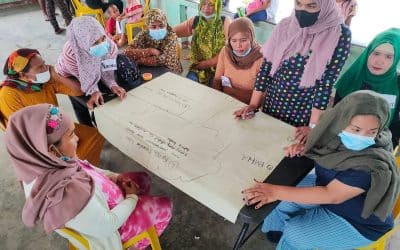InAsia
Insights and Analysis
Green Growth in Pakistan: A Necessary Paradigm Shift
August 28, 2019
With the ratification of an IMF bailout on May 12, Pakistan has now embarked on a difficult journey towards long-term economic stability. Some principal indicators suggest the extent of the pain: Inflation is expected to run around 18 percent in 2019–20. The Pakistani rupee has fallen significantly against the dollar, eroding national buying power, and the IMF projects a further fall, to 198.8 rupees per dollar, a 47 percent decline, by 2023. For a nation whose average income per capita is roughly $1,500 per year, this means carnage. Inflation is putting severe pressure on commerce, forcing firms to downsize or freeze investment due to high volatility and low returns. At the same time, the price of a basket of basic necessities is rising, making life increasingly difficult for the average Pakistani.

Early morning traffic in Karachi, Pakistan. Karachi is the largest city in Pakistan, with a population exceeding 20 million. Photo: Conor Ashleigh
As the soul-searching begins over the nation’s economic character and future direction, it is useful to consider a previous economic crisis of even larger scale, the Financial Crisis of 2008. Where observers had predicted, in the wake of that event, a worldwide reversion to fossil-fuel-guzzling, pollution-belching industries, we witnessed instead a global increase in sustainability efforts, as tracked by the S&P Dow Jones Sustainability Index.
Surprising? Possibly. Folly? Not at all. These efforts to go green actually made, and today still make, strategic sense. Unsustainable fossil fuels and environmentally irresponsible economic activities have serious costs, including fuel costs, collateral damage, and public relations nightmares (looking for a diesel Volkswagen, anyone?).
At this moment of economic decision, Pakistan has an opportunity to follow the green path. No longer are we an agricultural nation as of old. The largest share of Pakistan’s economy, 61.2 percent, is now in services, while industry and agriculture make up less than 40 percent. Sure, one might give Pakistan a pass: Why should a country whose GDP is less than $1,500 per person concern itself with civic notions of sustainability? With inflation hovering around 18 percent, new investment in sustainability is not encouraged by Pakistan’s macroeconomic environment. Sustainability may make sense in the long term, but the short-term cost of going green can be a substantial obstacle, a form of path dependency that has so far discouraged a green transformation.

Men repairing power lines in Karachi. Photo: Conor Ashleigh
But blame must also be assigned to civil society in Pakistan, which has so far failed to apply the bottom-up pressure needed to institutionalize the norms of sustainability. This is true despite a legislative environment that has been favorable. The Pakistan Climate Change Act, adopted in 2017, provides a basic framework for pursuing sustainability in the country. Now is the time for stakeholders in civil society to push for the realization of this basic framework in policymaking and implementation.
This is especially true when we observe the salient features of the Act. Specifically, it establishes three institutions to deal with climate issues. First, there is the Pakistan Climate Change Council (PCCC), which includes a broad range of national officeholders and representatives of civil society, and which sets the broad strategic aims of the nation’s climate regime. Second, there is the Pakistan Climate Change Authority (PCCA), a corporate body that can initiate legal actions, acquire assets, borrow and lend money, and enter into contracts. Finally, the policy establishes an independent fund to support the operations of the PCCA.
If there is a flaw in this structure, it is that the entire framework depends on top-down decision-making, starting with the PCCC adopting a broad strategic agenda. This dependence on the institutional hierarchy makes the entire regime prone to inertia. To keep the process moving forward, the not-for-profit sector must develop its own agenda for economic growth that is environmentally sustainable. This will require widespread advocacy programs and coordination among different economic sectors to make them cognizant of each other’s needs.

A consultative session held at the USAID Centre for Advanced Studies in Water at Mehran University in Jamshoro, Sindh, as part of the National Awareness Program in the Water, Energy, and Food Nexus.
The Asia Foundation in Pakistan has been encouraging coordinated thinking about the water, energy, and food sectors to alleviate the current policy incoherence among the nation’s many environmental stakeholders. Our national awareness program on the water-energy-food nexus, part of our Environmental Sustainability and Economic Development Program here in Pakistan, holds consultations with leading activists, academics, and government bureaucrats to develop a strategy to institutionalize coordinated, nexus-based thinking in these three interrelated areas.
The major challenge is to instill the value of sustainability in Pakistan’s private sector, and pressure from civil society will be essential to achieve this. The Asia Foundation in Pakistan has been conducting advocacy campaigns among major stakeholders to catalyze a conversation at all levels—from students to the highest echelons of government. Now, we need to build on this foundation. The industrial and service sectors provide well over three-quarters of our GDP. Given this, we need a new “sustainability platform” to help these engines of the private economy account for environmental costs and benefits. One promising example is PwC’s Total Impact Measurement & Management platform, which allows companies to calculate the economic, social, environmental, and tax consequences of their operations. Pakistan must adopt such platforms, localize them, and use them to promote an outlook that favors sustainability. Then, Pakistan’s future can be both green and prosperous.
Sarim Jamal is a program officer for The Asia Foundation in Pakistan. He can be reached at [email protected]. The views and opinions expressed here are those of the author, not those of The Asia Foundation.
About our blog, InAsia
InAsia is posted and distributed every other Wednesday evening, Pacific Time. If you have any questions, please send an email to [email protected].
Contact
For questions about InAsia, or for our cross-post and re-use policy, please send an email to [email protected].The Asia Foundation
465 California St., 9th Floor
San Francisco, CA 94104
The Latest Across Asia
News
April 25, 2024
Program Snapshot
April 18, 2024
News
April 17, 2024

2024 Lotus Leadership Awards
Thursday, April 25, 2024, New York City
The Lotus Leadership Awards recognize contributions towards gender equality in Asia and the Pacific







0 Comments